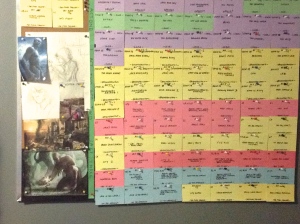Writing a screenplay is hard work… but it can be easy as well. When I first started out writing scripts, I had a really hard time finding my story and the right way to go about getting it done. I only had a few screenwriting books – not that they didn’t help, but over time, I realized a lot of the information was not quite complete and getting the writing process moving was a struggle. With today’s technology, we have more resources available to us: the internet, software and blogs which give us more answers to counter the challenges we all face as writers navigating the ever-expanding world of storytelling: writing stories that we are passionate about, that are fresh, original and pleasing to a world that constantly demands entertainment. Good stories never get old. With that in mind, I am an aspiring screenwriter who will never hit the end of the learning curve. Hopefully you can relate and learn from my writing adventures (the good and the bad). Here’s a summary of this journey so far:
Part Two: Brainstorming & Research
And now onto part 5: The Outline. My basic definition for it is this: a list/summary of all the scenes in your movie that make up its plot. The point of the outline is to map out your story so you know where you are heading with each scene. For those using ‘Final Draft’, there is a template which gives you an idea. I am sure there is a formal approach somewhere that people use, but considering the outline is for my eyes only, here’s what I do:
I write out a short, brief summary of every beat/ scene and what it’s about. Whatever comes to mind. Starting with each Act, the scenes/beats that takes place from plotpoint to plotpoint (see post from last week re: plotpoints). For some people, it can be cumbersome to do this. For me, it’s freedom because I basically put whatever I want – every relevant thought that comes to mind, without judging the merits of the content and worrying about script format, the good and the bad, etc. I also sometimes use the outline to experiment with scenarios, as well as jot down ideas regarding dialogue, action, etc. Usually writing the outline takes me about five to six weeks.
If you think this takes too long and prefer a simpler approach, the other way I like to do it is index cards… or combine both. That’s my wall above for a story I am currently working on.
Each set of index card colors represents a different plotpoint. Each individual index card has a couple of words of information regarding the specific scene that can be arranged or rearranged. When I was first starting out learning how to write a script, all I had was Syd Field’s “Screenwriting Workbook” – my introduction to screenwriting, so I never knew anything about outlines or beat-sheets. All Syd suggested (from my recollection) was to do a treatment and then head straight into index cards and putting all my scenes on them.
However, planning-wise, I found it just wasn’t enough, because once I started writing my first draft, I would still find some blanks and I would try to figure out these blanks while writing the first draft by typing within the Final Draft Document (Writer’s block, anyone? This is how it happens!). A big mistake in the first draft stage because the result is: you are trying to figure out what happens next while writing the script and then end up worrying about other things: the look, the writing, the formatting – literally opening a whole new can of worms. Which goes back to the question:
What is the great priority in a first draft?
The answer: GETTING THE ENTIRE STORY DOWN IN ONE GO.
There are ingredients and steps to every stage in the writing process. You can’t bake a cake without flour. Similarly, writing a first draft without a base is a bad idea – however, messing around with editing, formatting details while actually writing the script without knowing your story in its full entirety from beginning to end, is a BIG disaster waiting to happen. I would know – my first script went incomplete for years because of the following factors:
• Not enough preplanning and writing-on-the-fly (assuming I am going to be inspired as I write)
• Too much editing, fixing, worrying about the details.
Ok, so this might sound confusing to some – I just said you don’t want to be worrying about details while writing the first draft and yet I am saying the outline is all about the details. My point is: the outline is not your actual script – its a set of notes to navigate your way through writing your script. All your thoughts, all your hard work in the prep stages has led to this moment…so you have a complete script. The first draft is just the beginning of that journey – but it’s the most crucial step you will take to write your screenplay.
Next week: Writing the First Draft.

Pingback: My Writing: Day Seven | Firefly's Journal
Pingback: Word shuffle | Studio 1215 news Blog
Pingback: Writing the second draft | Write on the World
I love reading an article that will make people think. Also, many thanks for permitting me to comment!
Glad you enjoyed it!